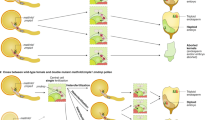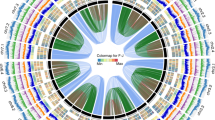Abstract
New breeding technologies accelerate germplasm improvement and reduce the cost of goods in seed production1,2,3. Many such technologies could use in vivo paternal haploid induction (HI), which occurs when double fertilization precedes maternal (egg cell) genome loss. Engineering of the essential CENTROMERIC HISTONE (CENH3) gene induces paternal HI in Arabidopsis4,5,6. Despite conservation of CENH3 function across crops, CENH3-based HI has not been successful outside of the Arabidopsis model system7. Here we report a commercially operable paternal HI line in wheat with a ~7% HI rate, identified by screening genome-edited TaCENH3α-heteroallelic combinations. Unlike in Arabidopsis, edited alleles exhibited reduced transmission in female gametophytes, and heterozygous genotypes triggered higher HI rates than homozygous combinations. These developments might pave the way for the deployment of CENH3 HI technology in diverse crops.
This is a preview of subscription content, access via your institution
Access options
Access Nature and 54 other Nature Portfolio journals
Get Nature+, our best-value online-access subscription
$29.99 / 30 days
cancel any time
Subscribe to this journal
Receive 12 print issues and online access
$209.00 per year
only $17.42 per issue
Buy this article
- Purchase on Springer Link
- Instant access to full article PDF
Prices may be subject to local taxes which are calculated during checkout


Similar content being viewed by others
Data availability
The authors declare that all data supporting the findings of this study are available in the manuscript and the Supplementary Materials.
References
Chang, M. T. & Coe, E. in Molecular Genetics Approaches to Maize Improvement (eds Kriz, A. L. & Larkins, B. A.) 127–142 (Springer, 2009)
Jacquier, N. M. A. et al. Puzzling out plant reproduction by haploid induction for innovations in plant breeding. Nat. Plants 6, 610–619 (2020).
Kelliher, T. et al. One-step genome editing of elite crop germplasm during haploid induction. Nat. Biotechnol. 37, 287–292 (2019).
Ravi, M. & Chan, S. W. Haploid plants produced by centromere-mediated genome elimination. Nature 464, 615–618 (2010).
Kuppu, S. et al. Point mutations in centromeric histone induce post-zygotic incompatibility and uniparental inheritance. PLoS Genet. 11, e1005494 (2015).
Kuppu S., et al. A variety of changes, including CRISPR/Cas9-mediated deletions, in CENH3 lead to haploid induction on outcrossing. Plant Biotechnol. J. 18, 2068–2080 (2020).
Kelliher, T. et al. Maternal haploids are preferentially induced by CENH3-tailswap transgenic complementation in maize. Front. Plant Sci. 7, 414 (2016).
Kelliher, T. et al. MATRILINEAL, a sperm-specific phospholipase, triggers maize haploid induction. Nature 542, 105–109 (2017).
Gilles, L. M. et al. Loss of pollen-specific phospholipase NOT LIKE DAD triggers gynogenesis in maize. EMBO J. 36, 707–717 (2017).
Liu, C. et al. A 4-bp Insertion at ZmPLA1 encoding a putative phospholipase a generates haploid induction in maize. Mol. Plant 10, 520–522 (2017).
Yao, L. et al. OsMATL mutation induces haploid seed formation in Indica rice. Nat Plants 4, 530–533 (2018).
Liu, C. et al. Extension of the in vivo haploid induction system from diploid maize to hexaploid wheat. Plant Biotechnol. J. 18, 316–318 (2020).
Liu, H. et al. Efficient induction of haploid plants in wheat by editing of TaMTL using an optimized Agrobacterium-mediated CRISPR system. J. Exp. Bot. 71, 1337–1349 (2020).
Zhong, Y. et al. A DMP-triggered in vivo maternal haploid induction system in the dicotyledonous Arabidopsis. Nat. Plants 6, 466–472 (2020).
Kalinowska, K. et al. State-of-the-art and novel developments of in vivo haploid technologies. Theor. Appl. Genet. 132, 593–605 (2019).
Yuan, J., Guo, X., Hu, J., Lv, Z. & Han, F. Characterization of two CENH3 genes and their roles in wheat evolution. New Phytol. 206, 839–851 (2015).
Karimi-Ashtiyani, R. et al. Point mutation impairs centromeric CENH3 loading and induces haploid plants. Proc. Natl Acad. Sci. USA 112, 11211–11216 (2015).
Maheshwari, S. et al. Naturally occurring differences in CENH3 affect chromosome segregation in zygotic mitosis of hybrids. PLoS Genet. 11, e1004970 (2015).
Jin, W. et al. Histone modifications associated with both A and B chromosomes of maize. Chromosome Res. 16, 1203–1214 (2008).
Deal, R. B. & Henikoff, S. Histone variants and modifications in plant gene regulation. Curr. Opin. Plant Biol. 14, 116–122 (2011).
Laurie, D. A. & Bennett, M. D. The production of haploid wheat plants from wheat × maize crosses. Theor. Appl. Genet. 76, 393–397 (1988).
Jaqueth, J. S. et al. Fertility restoration of maize CMS-C altered by a single amino acid substitution within the Rf4 bHLH transcription factor. Plant J. 101, 101–111 (2020).
Flood, P. J. et al. Reciprocal cybrids reveal how organellar genomes affect plant phenotypes. Nat. Plants 6, 13–21 (2020).
Evans, M. The indeterminate gametophyte1 gene of maize encodes a LOB domain protein required for embryo sac and leaf development. Plant Cell 19, 46–62 (2007).
Wright et al. Efficient biolistic transformation of maize (Zea mays L.) and wheat (Triticum aestivum L.) using the phosphomannose isomerase gene, pmi, as the selectable marker. Plant Cell Rep. 20, 429–436 (2001).
Gui, H., Liu, Y., Han, K. & Li, X. The relationship between PMI (manA) gene expression and optimal selection pressure in Indica rice transformation. Plant Cell Rep. 33, 1081–1090 (2014).
Loureiro, J., Rodriguez, E., Doležel, J. & Santos, C. Comparison of four nuclear isolation buffers for plant DNA flow cytometry. Ann. Bot. 98, 679–689 (2006).
Acknowledgements
We thank Z. Chai, L. Geng, Y. Liu, X. Zhang, R. Cui and Y. Ren for their work generating the genome-edited plants. Thanks to Y. Ma and Y. Zhang for data analysis. We thank Y. Gao and W. Teng for wheat outcrossing and G. Tang for gene sequencing and characterization of CENH3 expression. Thanks to M. Zong for ploidy analysis support and to W. Huang, C. Ma, Y. Pan, X. He, W. Jin, C. Gao and F. Han for technique suggestions. We thank J. Green, L. Kavanaugh, M. Rose and X. Tan for bioinformatics support and C. Leming for intellectual property guidance. We thank X. Zhang, D. Skibbe, X. Chen, J. Xu, K. White, T. Zhu, W. Cao, R. Quadt, B. Anindya, L. Shi, E. Dunder, I. Jepsen, G. Wu and B. Zhang for leadership and project guidance.
Author information
Authors and Affiliations
Contributions
J.L. and T.K. designed the experiments and wrote the manuscript. K.Y. managed plant care in the greenhouse, including seed increase and outcrossing. J.W. developed the genotyping strategy and conducted T2/F1 genotyping and KASP check. C.L. did the vector design and construction. H.G. and Y.W. performed the wheat transformation. H.Z. and J.L. sequenced T0/T1 genotypes. D.L. and J.L. performed pollen staining, stomata check and flower structure phenotyping, and R.C. performed the qRT–PCR of the three homoeologs of TaCENH3α and TaCENH3β in various tissues. T.L. analyzed histone modification sites. Q.Q., W.W., R.R. and X.Z. provided technique suggestions.
Corresponding authors
Ethics declarations
Competing interests
A patent covering the information in this manuscript was submitted on 2 October 2018.
Additional information
Publisher’s note Springer Nature remains neutral with regard to jurisdictional claims in published maps and institutional affiliations.
Supplementary information
Supplementary Information
Supplementary Figs. 1–4 and Tables 1–7
Rights and permissions
About this article
Cite this article
Lv, J., Yu, K., Wei, J. et al. Generation of paternal haploids in wheat by genome editing of the centromeric histone CENH3. Nat Biotechnol 38, 1397–1401 (2020). https://doi.org/10.1038/s41587-020-0728-4
Received:
Accepted:
Published:
Issue Date:
DOI: https://doi.org/10.1038/s41587-020-0728-4
This article is cited by
-
Precise fine-turning of GhTFL1 by base editing tools defines ideal cotton plant architecture
Genome Biology (2024)
-
One-step creation of CMS lines using a BoCENH3-based haploid induction system in Brassica crop
Nature Plants (2024)
-
Cyto-swapping in maize by haploid induction with a cenh3 mutant
Nature Plants (2024)
-
Haploids fast-track hybrid plant breeding
Nature Plants (2024)
-
Potential gene editing targets for developing haploid inducer stocks in rice and wheat with high haploid induction frequency
3 Biotech (2024)



